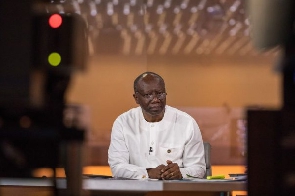 Finance Minister, Ken Ofori-Atta
Finance Minister, Ken Ofori-Atta
The macroeconomic data of the country is flashing red light signals of danger ahead, as it is showing rising debt levels against shortfalls in revenue amid the impact of coronavirus pandemic; thereby worsening fears that the economy is at high risk of debt distress.
The Summary of Economic and Financial data (May 2020) shows that in March – the very month Ghana recorded its first case of the novel coronavirus – the public debt increased to 59.3 percent of GDP, a 1.9 percentage point higher than what was recorded in February 2020.
Compared to March 2019, the debt to GDP figure was 56.7 percent, 2.6 percentage points lower than this year’s – pointing to the fact that negative impacts from the pandemic led to some unexpected and unbudgeted expenditure which could not be financed with domestic resources.
The point is much clearer when the revenue situation is drawn into the discussion, especially when compared with the pre-COVID era. Total revenue and grants as of March this year stood at 2.7 percent of GDP, compared with 3 percent recorded in the same period of 2019.
This decline also reflected in both domestic and tax revenue mobilization.
Domestic revenue mobilization saw a 0.4 percentage point drop from last year to record just 2.6 percent of GDP in March this year; while tax revenue mobilised accounted for just 2.2 percent of GDP – a 0.2 percentage point decline from last year.
The declines can be blamed on loss of tax revenues due to closure of borders, which has ground to a halt trade-activities among countries.
The above figures show that the economy continues to struggle in raising enough revenue domestically to take care of its needs, hence the insatiable appetite for borrowing and thereby affecting the primary balance – which essentially means the ability to pay off debts using internally generated revenue.
The primary balance figure, although it has shown a negative balance on a 12-month trajectory, worsened in March this year. It recorded -1.7 percent balance compared to -0.2 percent in March 2019, the poorest in the period under consideration.
The overall balance on cash basis makes the situation even more desperate, as the amount has further contracted by 3.4 percent against -1.6 percent in February 2020 and -1.3 percent in March 2019.
Commenting on this, the Dean of Business School-University of Cape Coast, Prof. John Gatsi, said arrival of the coronavirus pandemic, matched against the revenue situation, paints a disturbing picture for debt sustainability of the economy.
“When you are looking at a country’s financial position, you not only look at the debt portfolio but should also look at whether the country is able to pay its indebtedness given the revenue it mobilises, then you can say that the country’s debt is sustainable.
“The primary balance focuses on whether you are able to look for money within to finance your interest payments. So, if you cannot do that, then it means that your debt level is not sustainable. So the current figures show that our inability as a country to mobilise money within to service our debt has worsened and we can only pay our debt by borrowing, and this is not good for us.
“The coronavirus is only deepening the situation. Because the primary balance has something to do with revenue mobilisation, and has something to do with our expenditure, as long as our expenditure is going high during the COVID period we are only deepening the situation,” he told B&FT in an interview.
The World Bank and IMF have constantly warned, even before the pandemic, that the country is at high risk of debt distress. So, with the pandemic showing up in the picture, that warning is gradually becoming real. And knowing Ghana’s historical problem with revenue mobilisation and borrowing to finance government expenditure, it will take some kind of miracle to avert the fate of plunging the economy into debt distress.
Prof. Gatsi says the monies borrowed should end up in productive ventures, or else the situation will continue to be dire.